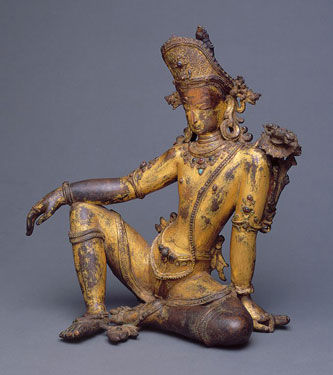The New Alsdorf Galleries of Indian, Southeast Asian, Himalayan, and Islamic Art @ The Art Institue of Chicago
God Indra, 16th century. Kathmandu Valley; Nepal. The James W. and Marilynn Alsdorf Collection
CHICAGO, IL.- The Art Institute of Chicago will reveal two new suites of galleries devoted to Asian art on December 13, 2008: the Alsdorf Galleries of Indian, Southeast Asian, Himalayan, and Islamic Art (G140-G142), previously known as Gunsaulus Hall; and the Galleries of Indian and Islamic Art (G151-G152) on the north side of McKinlock Court. Both of these new spaces offer visitors more of the museum's renowned Asian art collection, and they feature the only space in the museum outside of the Modern Wing designed by Renzo Piano. This new home for South and Southeast Asian art cohesively includes more than 430 sculptures, artifacts, and paintings from the Art Institute's holdings--many of them from the Marilynn B. and James W. Alsdorf Collection of Indian, Southeast Asian, Himalayan, and Islamic Art --that have in the past been displayed only in temporary or special exhibitions. These galleries create a new crossroads for the museum, bringing together a remarkable collection that spans centuries and creates a literal bridge from the arts of East Asia to the ancient art of Western civilization and the Modern Wing.
"The completion of the Alsdorf Galleries is vital to our presentation of Asian art, and it deepens our commitment to serving a global population. How fitting that Asian art will now fill the very center of the Art Institute, serving as a link between the existing museum and the Modern Wing," said James Cuno, President and Eloise W. Martin Director of the Art Institute of Chicago. "We are thrilled that so many treasures from the Alsdorf Collection will finally be on permanent display, thanks to Marilynn Alsdorf's exceptional generosity."
"The Art Institute is home to one of the world's strongest holdings of Asian Art," said Alsdorf Associate Curator Madhuvanti Ghose. "Because of space limitations, however, visitors have rarely been able to see the full strength and depth of the collection. The Alsdorf Collection stands out as a true jewel among the museum's holdings, internationally recognized for its scope, beauty, and quality. I am thrilled be a part of this massive project of unveiling this collection and showcasing it for museum visitors."
The Alsdorf Galleries represent the complete transformation of Gunsaulus Hall, previously a windowless walkway filled with the museum's collection of European arms and armor. Gunsaulus Hall was built over the railroad tracks that pass under the Art Institute in 1916. The original windows were bricked over in the 1930s because of the amount of soot and dirt created by the train lines. Now renovated by Renzo Piano, the Alsdorf Galleries are a light-filled space with views of Millennium Park and the Chicago skyline. Piano opened a 56-foot section of the original walls, increased the height of the ceiling, and added new, light wood flooring. The result is a clean and modern space that brings the existing building of the Art Institute into a dialogue with the Modern Wing. The Harding Arms and Armor collection, formerly occupying Gunsaulus Hall, will once again be on display in the museum when the renovations to the Art Institute's European painting and sculpture galleries are complete in 2010.
The new Asian art spaces extend from existing galleries that house the art of China, Japan, and Korea. A full connection to the new galleries is created by the axis between the famous large Buddha, in the entry space to the Asian galleries, and the 12th-Century stone Buddha from South India in the center of the Alsdorf Galleries. On this axis viewers will find exquisite objects of Himalayan art, many of which have not been seen on view since the 2003 exhibition Himalayas: An Aesthetic Adventure. The center of the Alsdorf Galleries feature works from one of the strongest sections of the museum's collection of South Asian art: classical and medieval Indian sculpture. Works in this area represent not only the diversity of Indian culture itself but also focus on religious subjects.
The new Galleries of Indian and Islamic Art on the north end of McKinlock Court contain later works of Indian art representative of pre-1947 India and also its Imperial Mughal and royal past. Works from Middle Eastern and Islamic cultures of South Asia complete the redesigned space. These galleries will feature rotating exhibitions featuring works from such countries as Burma, Thailand, Cambodia, Vietnam, and Indonesia, allowing the museum to present focused displays of work from these cultures and time periods.
This rejuvenated emphasis on the Asian art collection completes the second phase of the most ambitious renovation and reinstallation project in Art Institute history, coinciding with the construction of the Modern Wing. The Alsdorf Galleries and the Galleries of Indian and Islamic Art will be launched with an exclusive gala event on December 12, 2008, and they open to the public on December 13, 2008.

/https%3A%2F%2Fprofilepics.canalblog.com%2Fprofilepics%2F1%2F0%2F100183.jpg)
/https%3A%2F%2Fstorage.canalblog.com%2F03%2F02%2F119589%2F96711876_o.jpg)
/https%3A%2F%2Fstorage.canalblog.com%2F11%2F31%2F119589%2F94773502_o.jpg)
/https%3A%2F%2Fstorage.canalblog.com%2F20%2F83%2F119589%2F94772815_o.jpg)
/https%3A%2F%2Fstorage.canalblog.com%2F26%2F72%2F119589%2F75604929_o.jpg)
/https%3A%2F%2Fstorage.canalblog.com%2F59%2F60%2F119589%2F26458628_o.jpg)



/image%2F1371349%2F20240418%2Fob_ac5c4c_telechargement.jpg)
/image%2F1371349%2F20240418%2Fob_709b64_304-1.jpg)
/image%2F1371349%2F20240418%2Fob_22f67e_303-1.jpg)
/image%2F1371349%2F20240417%2Fob_9708e8_telechargement.jpg)